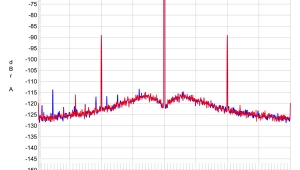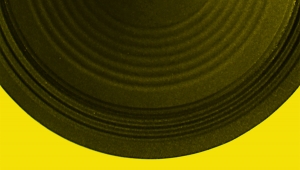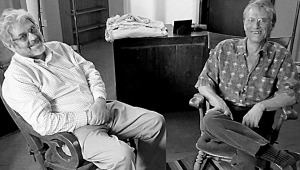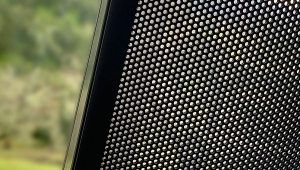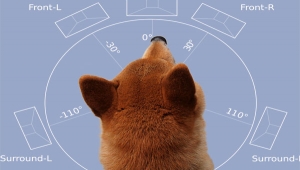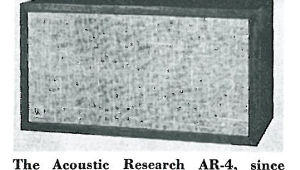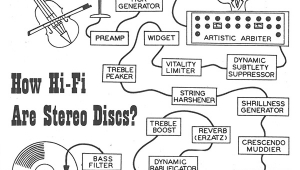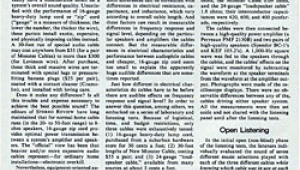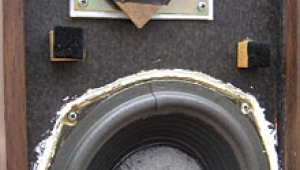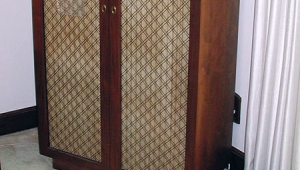| Columns Retired Columns & Blogs |
Fisher 500-C vintage stereo receiver Page 2
The Fisher 500-C uses 7591A output tubes, now discontinued. Until recently, you had to buy used or NOS (new old stock) 7591As, but a new 7591A, the 7591A EH, is now being manufactured in Russia by Sovtek under the Electro Harmonix label (footnote 4); four can be had for less than $100. It's a bit bigger than the original, but it still fits the 500-C's sockets and inside its handsome wood cabinet. The new tube is fantastic—it sounds far better than the original 7591A in this application. The 7591A EH offers better dynamics, deeper and much tighter bass, greater air and space between instruments, and a wider, deeper soundstage. The new tube requires no circuit modifications, and it transforms the 500-C's sound from good to great, and reduces the stress of having to find NOS or of using second-hand tubes of dubious condition.
Footnote 4: We should thank our guitar-playing brothers for supporting the tube resurgence. They dig tube sound as much as we do, and have increased the demand for vintage output tubes for their Fender, Vox, and Marshall amps. The market has met demand with new tubes from old factories in Russia and Eastern Europe, and it's good news for all of us.
Tone it down
The best features of the 500-C are its tone controls: Bass, Treble, and Loudness Contour.I always thought that tone controls wreaked havoc with transparency and added unimaginable amounts of hash and grain, but the 500-C's rudimentary equalization is surprisingly nondetrimental. Little did I know how much it can enhance the listening experience and transform previously unplayable recordings. For instance, played "flat," the open-reel tape of Frank Sinatra's September of My Years sounds terrible (Reprise FS-1014, 4-track, 7.5ips)—hot, horribly bass-shy, with a truncated lower midrange. It sounds as if the woofers have been turned off. An aggressive low-frequency boost is the ticket. A flip of the Fisher's Loudness switch plus a boost of the Bass knob to 2 o'clock turns this unlistenable dog into a great recording. Magically, Sinatra's voice takes on lifelike, three-dimensional presence, emerging from the mix in seductive, you-are-there naturalness. It's amazing. Think of how many bad recordings you have in your collection. Perhaps a nip and tuck of the treble, or padded-down midbass bump, will turn those ugly ducklings into majestic swans.
After you've cut and boosted and contoured that nasty first-generation Mamas and Papas CD, you look at the time and the kids are asleep. Don't panic—chill out, plug in your Sennheiser headphones, and crank it up. The 500-C's front-panel headphone jack gives you the full power of the 7591A EH output tubes. The very same reference sound your speakers see is what the jack delivers. But before you put the phones on, be sure to turn down the volume pot—the jack is always connected to the sound source.
Sound
I placed the Fisher on Walker Audio cones for vibration control and wired in a set of banana-plug speaker-terminal adapters, available from WEAudio in Hong Kong (footnote 5). 1960s-vintage speaker lug terminals are narrow binding strips that predate today's fancy spades and bananas plugs. Also, the input jacks on the 500-C are so close together that it's a tight fit for exotic RCA plugs. Seek out cable brands that use standard size jacks. I've had success with Kimber KCAG, Nordost Red Dawn, and Acoustic Research.
No matter how much I like music, I like the sound, too. What suits me best is a big, full-force dynamic-range system that can image and be delicate at the same time. I'm not satisfied unless a system can excel with both a willowy 16th-century motet and a Count Basie big band. I also demand neutrality, and, believe it or not, this vintage stuff delivers. I always thought the old stuff would sound overly colored or warm. However, the biggest surprise of vintage gear was finding that this was not so. I'm not an antique audio collector or an apologist for single-ended triodes (SETs). I coax great sound from solid-state and tubes. I would never go vintage because it's cool or hip. I'm gaga over vintage for the sound.
I've auditioned many classic vintage amplifiers over the years. The Fisher 500-C is very special, with that rare ability to draw me into the sound and the music. It's in the same league as the first wave of SET all stars: Baby Ongaku (footnote 6) Wavelength Cardinal, Welborne Laurel, Komuro 845, and Wright Sound WPA 3.5. The Fisher's line stage is clear, concise, and crisp, though not as crystalline-pure as the Convergent Audio Technology Ultimate's.
The Fisher's foremost sonic attribute is its uncanny ability to reproduce enormous spatial presence. It reproduces ambient air and natural reverberation better than all but a few, exceptionally priced pieces of audio art. "The Sunne Rising," from Paul Hillier and Nigel North's Rags of Time: 17th-Century Lute Songs (CD, Harmonia Mundi HMU 907257), offers one of the greatest spatial palettes I've heard in recorded sound. Hillier reads the poem, accompanied by lute, in what appears to be an old European cathedral. (It's actually the studio at Lucasfilm's Skywalker Ranch.) If you close your eyes tight, you can smell the stale air and renaissance odors. It's remarkable.
The Fisher's dynamic range is explosive. Its bass is tight, punchy, and electrifying. It grabs you around the knees and rips your socks off. If your taste borders on the bizarre, spin the syncopated rhythms and cut and scratch samples of Bryn Jones' Muslimgauze (his later body of work). If you have the nerve to turn it up, "Marble Mosque," from Hummas (CD, Soleilmoon SOL 104CD), will test your speakers' low-octave abilities. The out-of-phase explosions of electronic ripping and shredding will grip you by the throat and leave you gasping for air. Jones' low-frequency effects are terrifying; when he combines them with startlingly sharp cymbal attacks scattered throughout your room, you'll stare in disbelief at this 40-year-old tube receiver. It's a lottery win for your ears.
The 500-C's soundstage compares with anything out there, whether single-ended, push-pull, or solid-state. My test for this is Dick Hyman's Age of Swing (LP, Reference RR-59), a once-in-a-lifetime record that does everything right. The band is hot, and the sound is front-row center, the players set up in a virtual-reality semicircle inches from your face. It is the most enveloping recording in my collection, and my número uno desert-island LP. The Fisher retrieves the instrumental spatial cues perfectly and nails the images firmly in a realistic soundfield that's as close to live as a recording can be. The layers are exact, and the width extends beyond the speaker sides. The speakers "vanish."
The Fisher's transient attacks are clear, and packed with harmonic overtones. Instrumental decay is somewhat better than leading-edge definition due to the masking effect of a subtle but voluptuous lower-midrange plumpness. This, an often good thing for early digital releases, is one of the few faults I hear in the 500-C, and is apparent only when the Fisher is tested against my reference Komuro Audio Labs 212 SET (footnote 7).
Conclusions
Why is the Fisher 500-C so magical? It does not have audiophile-approved parts. It has no resonance-control stuff or secret potted circuits. Nothing is cryogenically treated. It's built on a standard steel-plated chassis. With its active tone controls, it's the antithesis of the purist audio approach. I suspect its magic is based on good engineering, intelligent voicing, and high-quality transformers.
I'll be first to tell you that the Fisher 500-C does not have the effortless headroom or bass extension of a Krell Full Power Balanced 600 (slight cost difference). It does not have the purity of tone or crystal-clear naturalness of the flea-powered (3.5W) Wright Sound WPA 3.5. However, it has more pace and drive than the Wright, and can mate with a greater number of speakers. The Fisher's 35Wpc is comparable to a Dynaco Stereo 70's, as is its second-hand price. I've lived with both, and I now own five 500-Cs and no Stereo 70s. The Dynaco is a very good amp, but it lacks that nth degree of palpable realism that the Fisher delivers in spades.
The Fisher has a big, robust sound. Like an Islay single-malt whisky (footnote 8) it's delicate but raucous and can kick some serious butt. It's detailed without being sterile, musical without being sappy. It's the "All of the above" box on the audiophile SAT. It's also remarkably affordable and a simple mouse click away.
Avery Fisher's 500-C may unlock new worlds for the adventurous audio thrill-seeker or it may simply be an affordable solution for the summer home. It will definitely put some fun back into your listening obsession. Avery Fisher was right about those "unlimited years of musical enjoyment." The Fisher 500-C will blow apart your expectations of vintage audio.
Footnote 4: We should thank our guitar-playing brothers for supporting the tube resurgence. They dig tube sound as much as we do, and have increased the demand for vintage output tubes for their Fender, Vox, and Marshall amps. The market has met demand with new tubes from old factories in Russia and Eastern Europe, and it's good news for all of us.
Footnote 5: WEAudio sells assorted vintage parts. Proprietor Woo Yik Fan operates an eBay store under the name "we audio." The speaker binding-strip adapters accept heavy-gauge stripped wire and/or traditional banana plugs and are essential for connecting speaker cables to vintage amps. $11/pair plus shipping.
Footnote 6: Art Dudley writes about this DIY amp in his September 2004 "Listening" column. It was scruffy and looked very homemade. I wonder where it is now.
Footnote 7: This $44,000, limited-edition amplifier is based on the Western Electric 212 transmitting triode tube, the big brother in the 211 family. A full 3" in diameter and 12" tall, this tube produces 60Wpc SET, and its low plate impedance, hence high damping factor, enables it to drive large, cost-no-object loudspeakers. The 212 triode has the reputation of producing solid-state–like bass along with SET-like tonality and realism.
Footnote 8: Pronounced EYE-luh. Scotch whisky from this island region is big and complex, with a warm, peaty finish. Connoisseurs of single malts consider Islay whisky the best in the world.
- Log in or register to post comments

